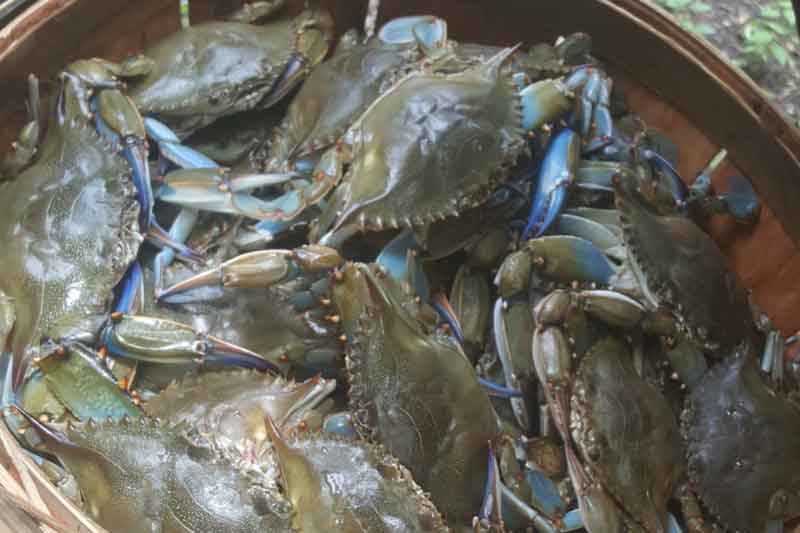Skateboard Pilates, floating yoga, aqua spin: while it seems like people are always finding new and evermore elaborate ways to get in shape, it’s hard to imagine your average kale-wielding-millennial trading in their tank tops and yoga pants for a windbreaker and a pair of waders. CrossFit enthusiasts may think that crabbing lacks the nuance of flipping a truck tire across the floor of a converted RadioShack, and that the angler bod isn’t likely to become the hot new look sweeping social media in 2020. But what those man-bunned naysayers don’t realize is that while you’re bagging crustaceans, you’re also burning calories.

Feel the Burn
Crabbing’s caloric crux lies in its tendency to culminate with the crabber in question consuming the crabs they’ve caught. For many recreational crabbers, eating their catch is the best part. Unfortunately, you can’t burn calories while eating, right? Well, it turns out you can and do. Take eating celery for example. For less health-conscious individuals like myself, celery is viewed predominantly as a vehicle for ranch dressing that is often found lying on the outskirts of a plate of chicken wing detritus. However, some people insist that, when eaten without creamy salad dressing, celery is calorie-negative. That means that it provides less calories than it takes to chew up and digest it. So, can the same be said for crabs?
You can usually get about two ounces of meat out of a normal sized blue crab, and (according to the USDA) 135 grams of Chesapeake blue crab meat contains 112 calories. That means that an average crab yields about 47 calories. It’s difficult to say how much energy your body uses while breaking down crab meat but, given that a stalk of celery is only six calories and – let’s say – more digestively formidable, we can assume it’s negligible. The majority of energy expended during crustacean consumption is due to the effort required to crack the crab.
To figure out just how many calories crab-cracking consumes we have to use MET (metabolic equivalent of task) levels, which express how many calories you burn doing an activity compared to when you’re at rest. According to the CPA (Compendium of Physical Activities) the MET level for eating is 1.5. But given that cracking crabs takes a fair bit of elbow grease 2.0 is a more accurate estimate, meaning you burn twice as many calories as you would sitting quietly. The formula for energy expenditure (Weight in kilograms x 0.0175 x MET level) is used to calculate how many calories an individual burns per minute while performing a certain task. An average American adult male weighs about 198 pounds (90 kilograms in the metriculated version), so they’ll burn 3.15 calories every minute they’re chowing down. Assuming it takes about 15 minutes to pick a crab clean, that means that cracking one crab burns 47.25 calories. This (almost too conveniently) means that you’re burning a quarter of a calorie for every crab you eat. So, if you ever see a coworker smugly eating carrot sticks in the break room, hold your head high and slam down some jimmies.
How, then, does crabbing compare to CrossFit? Let’s say our 198-pound average American male gets on his average American fishing boat and goes on a four-hour crabbing trip. The CPA estimates that MET level for recreational crabbing is 4.5, but it doesn’t really specify if it’s based on trot lines or pull traps and if that number applies for the entire trip or only when you’re actually pulling lines. The CPA also lists powerboating with an MET level of 2.5, so a conservative estimate for this average American crabbing trip might be 3.0. Using the energy expenditure formula, that means our 198-pound American male will be burning 1,134 calories. Using the CPA’s values for vigorous aerobic exercise, that’s the equivalent of a 90-minute CrossFit class, or a seven-mile run.

This isn’t to say eating crabs is totally guilt-free or that exercising is only about burning calories. An average-sized crab may be calorie-negative, and while it does have twice the protein of an egg, it also has 19-percent of your daily value of cholesterol (not to mention the Old Bay). So while it might be a good idea to work out every now and then, it doesn’t have to mean going to a gym and buying trendy workout clothes.
Crabbing probably won’t be the next big health craze, even though a recreational crabbing license is a heck of a lot cheaper than a gym membership. Plus, an internal sense of accomplishment is great and all, but I’d prefer a bushel of crabs.
-By Ryan Gullang
Three Ways to Enhance Your Crabbing Workout
You say your New Year’s Resolution is to lose 30 pounds next year? Go crabbing as often as possible in 2020, and use these measures to help ensure it happens:
- Trade in your light aluminum crabbing net for one with a two-inch-thick, 10-foot wood handle that weighs twice as much.
- Use 50-pound weights to anchor your trot line.
- Bait up your trot line with whole chickens, instead of just the necks.